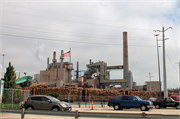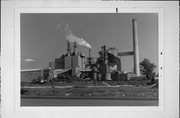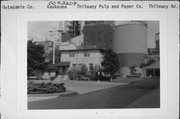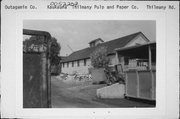Property Record
THILMANY RD
Architecture and History Inventory
| Historic Name: | THILMANY PAPER MILL |
|---|---|
| Other Name: | AHLSTORM MUNKSJO |
| Contributing: | |
| Reference Number: | 52207 |
| Location (Address): | THILMANY RD |
|---|---|
| County: | Outagamie |
| City: | Kaukauna |
| Township/Village: | |
| Unincorporated Community: | |
| Town: | |
| Range: | |
| Direction: | |
| Section: | |
| Quarter Section: | |
| Quarter/Quarter Section: |
| Year Built: | 1919 |
|---|---|
| Additions: | |
| Survey Date: | 1988 |
| Historic Use: | mill |
| Architectural Style: | Astylistic Utilitarian Building |
| Structural System: | Concrete Beam |
| Wall Material: | Brick |
| Architect: | |
| Other Buildings On Site: | Y |
| Demolished?: | No |
| Demolished Date: |
| National/State Register Listing Name: | Not listed |
|---|---|
| National Register Listing Date: | |
| State Register Listing Date: |
| Additional Information: | A 'site file' (Kaukauna Historic Properties) exists for this property. It contains additional information such as correspondence, newspaper clippings, or historical information. It is a public record and may be viewed in person at the Wisconsin Historical Society, Division of Historic Preservation-Public History. Photo code: FCS 5/13. Thilmany Plant #2 is a modern papermill, an irregular, multistory complex of interconnected cement and metal buildings and structures, served by a complex of roads and rail lines leading to its restricted site. "The only remaining representative of a large number of Kaukauna paper mills established in the late nineteenth century...While representative in the large sense as a producer of the specialty-type papers produced in the Fox River Valley, Thilmany is unique among regional mills for the kinds of specialty papers produced, especially those closely associated with the food industry. Moreover, it is one of a few Valley mills using the sulphate pulp process, an alkaline process, consistent with the use of softwood. The buildings, today only a portion of the company complex, show the historical development of the firm from 1889-1941, years when the firm secured its place in the paper industry. Since that time, Thilmany has developed in the same direction diversifying into more specialty lines until today they claim a variety of 5,700 different paper products. The midwestern paper industry developed its greatest regional concentration along the Fox River between the years 1870 and 1890, and especially during the second ten years of that period. The Fox River had an unusually even flow making it a reliable source of water (for wood pulp) and its falls produced ample horsepower to turn the main shafts of the belt driven industrial machines of the day. The largest falls are at Appleton, Kaukauna, and Little Chute which produced about 80% of the available water power of the Fox. The largest of these falls is at Kaukauna. However, it was not the first to nurture the pulp and paper works. These began at Neenah-Menasha and Appleton, center of settlement, where the water of the Fox had previously been tamed by canals and its power made accessible to flour and woodworking mills. As paper mills expanded in response to market demands, mills developed at downstream sites and at Kaukauna, where in 1883m the American Pulp and Paper Company was formed by Milwaukee bankers, and began operation in the following year. The manager, Oscar Thilmany, kept the business afloat and by 1889 had bought out the other partners and renamed the firm, Thilmany Pulp and Paper Company. Thilmany's company, one of eight located at Kaukauna during the 1880s, was average in size, equal in terms of capital investment to most of the other Fox mills. While it did not expand as some, Kimberly-Clark for example, it survived by adaption so that today it is the sole representative of the industry at Kaukauna. After working briefly with groundwoof pulp, Thilmany produced pulp from the sulphite process, which permitted the production of stronger papers, for wholesale and retail packaging, the field with which the company has been identified, though many diversifications, to the present day. The first period of the company's history ended in 1901 when Thilmany sold his interests to a group of investors led by Arnold Wertheimer who became president of the firm. At this point in its development, Thilmany employed about 100 workers and its plant inventory included five Fourdrinier machines, four Jordan refiners, six beaters, three rewinders, two dynamos, two elevators, four boilers, and a conglomeration of converting machines. Wertheimer's presidency, an era of expansion, which except for depression years, lasted until 1936, may be divided into two periods, 1901-1918 and 1918-1936. The first period was characterized by the development of more sophisticated wrapping papers including glassine and especially wax and asphalt coated papers. It was during this period that Thilmany began its long and profitable production of wax cracker box liners for the National Biscuit Company, an association which lasted until 1938. In 1913, the company switched from sulphite to sulphate process pulp, the better to produce those specialty papers. It was this process which gave the mill its characteristic smell. The second period centered on the expansion of pulping facilities at the No. 2 plant and the creation of additional pulp supplies at a mill in Washington State. These activities, crucial to the continued growth of Thilmany, did not much effect the physical appearance of mill No. 1...Yet it was at that site that the papers, for which the company was nationally famous, were, to a large extent, produced. Some measure of the importance of these increased pulp supplies is shown in the growth of employment to 550 workers in 1939. At the end of this period, the production operations in No. 1 were shabby and it became the focus of a general plan of reorganization, which featured the concentration of converting operations, labs, and management of activities at the site. Paper production was removed to the lower mill and the original machines were sold. *Note: Information was taken directly from the individual National Register form prepared by Paul Abrahams, Associate Professor, UW, Green Bay, January, 1983." Walking Tour Through Old Kaukauna: Two Self-Guided Historic Tours Kaukauna, Wisconsin, City of Kaukauna, 1983. |
|---|---|
| Bibliographic References: | Walking Tour Through Old Kaukauna: Two Self-Guided Historic Tours Kaukauna, Wisconsin, City of Kaukauna, 1983. |
| Wisconsin Architecture and History Inventory, State Historic Preservation Office, Wisconsin Historical Society, Madison, Wisconsin |




